| wOBA | xOBA+ | K % | BB % | O-Swing % | Contact % | SwgStr % | Hard Hit % | EV | LA | |
| Player A | .330 | 108.3 | 13.6% | 9.3% | 28.1% | 85.9% | 6.4% | 36.5% | 88.6 | 5.7 |
| Player B | .340 | 115.8 | 12.9% | 8.3% | 30.3% | 83.6% | 7.7% | 33.5% | 88.4 | 7.7 |
Nothing like a little player comparison to start things off. Mystery man A just set career highs in H, HR, RBI, BB, R and paced the senior circuit in triples. Yes, 2018 was a pretty nice year for one Ketel Marte. Having just turned 25 this off-season and done all this you’d figure there would be a little bit more than the seemingly tepid interest surrounding him but here we are. Alright, I should be fair here I guess it’s not all that surprising to see mediocre interest since, after all, we are talking about a player that doesn’t appear to have one overly loud trait and despite all the career highs was just barely above league average with a 104 wRC+. But make no mistake about it Ketel Marte has a very particular set of skills that shouldn’t be overlooked. And he’s improving. Which brings us to player B. This is a player who, similar to Marte, scouts were ambivalent in projecting his power potential. That is until he made a substantial improvement. We’ll circle back to player B later, for now, let’s take a closer look at those aforementioned skills.
On-Base and Contact skills
| PA | K% | BB% | O-Swg% | Con% | SwgStr% | OBP | |
| 2016 | 466 | 18% | 3.9% | 33% | 83.3% | 8% | .287 |
| 2017 | 255 | 14.5% | 11.4% | 31.6% | 84.4% | 7.3% | .345 |
| 2018 | 580 | 13.6% | 9.3% | 28.1% | 85.9% | 6.4% | .332 |
Well, one thing’s for sure. Ketel makes contact and a lot of it. There are a couple trends to take note of here. One of which are gains in contact. Along with a rise in contact rate, both his K rate and Swinging strike rate have dropped in each of the last three years. Which is pretty impressive when you consider that he was already above average at making contact in 2016. For reference, the average Contact % is roughly 80% and the average swinging strike rate is right around 9.5%. Simply put his ability to put the bat on the ball is exceptional. And that was on full display last year. In 2018 his 6.4% swinging strike rate and 13.6% K rate were good for 18th and 19th respectively among qualifiers. His 85.9% contact rate was also good for 18th among qualifiers. The second trend to note here is a drop in O-Swing % (swing rate at pitches outside the zone) in three straight years. So we have a player who makes a ton of contact and is now also showing better knowledge of the strike zone. Last year’s OBP of .332, while not incredibly impressive at face value was still above average and perhaps even more so when you consider it was good for 8th among fellow qualifying 2nd basemen.
He’s Got Speed.
The one thing that’s been somewhat puzzling with Marte is that he hasn’t shown the proclivity to steal at the major league level. Especially considering that he stole 20 bases twice in the minor leagues once in 2014 and in 2015. It’s certainly not for lack of speed – last year’s sprint speed of 28.7 ft/s was good for 79th and we mentioned earlier the league-leading tally in triples. Perhaps he’s just not a very adept base stealer. He’s been successful on 28 of 39 attempts for his career which comes to 71.7%. That’s a little less than the 75% success rate generally deemed desirable but certainly not egregiously so especially considering the limited sample size. Maybe Marte opts to be a little more aggressive on the base paths next year with Goldschmidt no longer hitting behind him. But that is of course entirely speculative. Regardless I don’t think you can rule out the possibility for double-digit steals next year.
…And Power?
Well, he was never supposed to have power. But then he started to do some things. Very loud things.
Marte keeps his hands back nicely and absolutely unloads on a hanging breaking ball from Andrew Suarez. A 465 foot 112.8 EV MPH bomb. Well, that’s not something you’d expect from someone with no power. How about another one.
Kershaw thinks he can sneak a 1-0 fastball by him. Maybe a couple of years ago he could but not now. Marte launches one 455 feet at 110.9 MPH. I think Marte has some power. Marte was also billed as a hitter with advanced pitch recognition even at a young age. We can see those skills to work in an at-bat against German Marquez.
It’s really not a bad pitch from Marquez as he drops a curveball on the outer half. But Marte flashes his exceptional bat to ball skills as keep his hands back and goes with the pitch slashing it to left-center. The ball splits the gap and the result of the play is a triple.
Some Exciting Trends
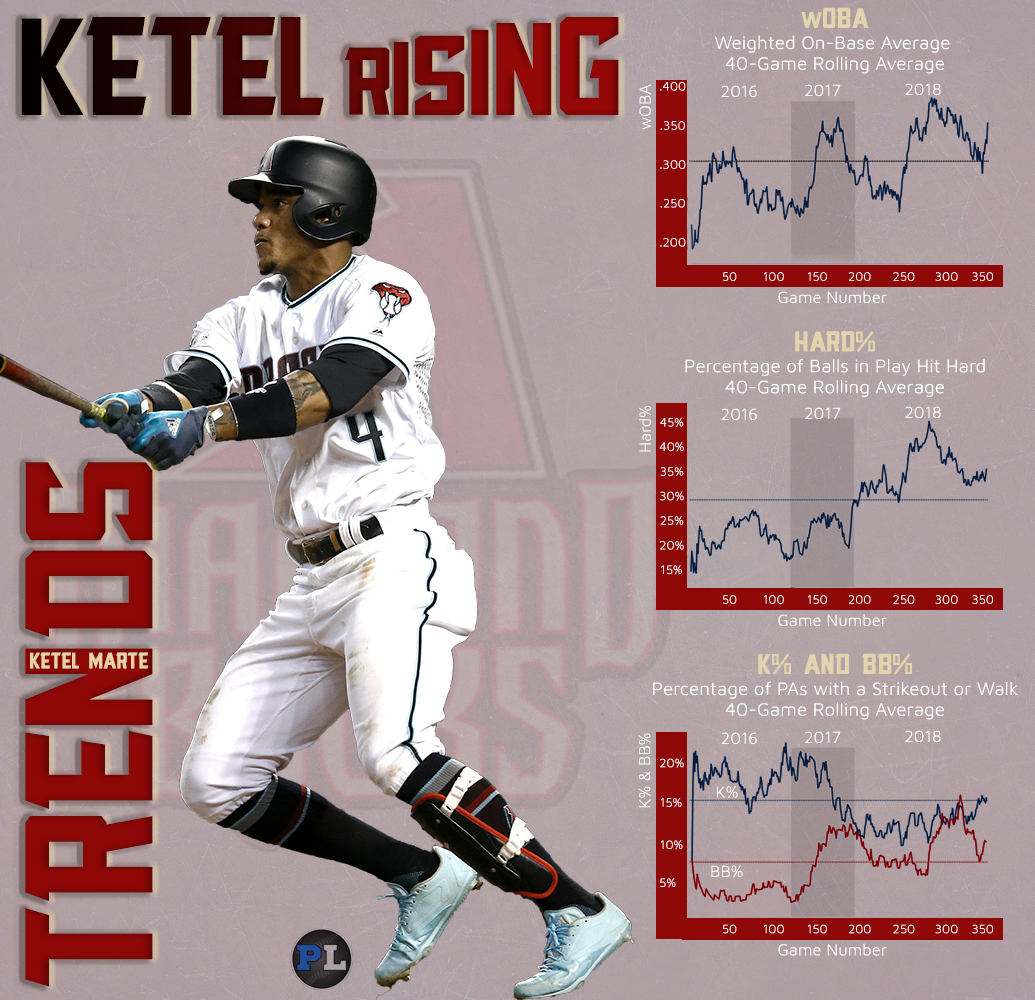
Graphic by Justin Paradis (@freshmeatcomm on Twitter)
There are quite a few tantalizing trends for Marte following 2018. Strikeout rate and chase rate down. Contact rate, hard hit rate and wOBA all up. Now to be fair some of these trends started in earnest last year. The results were just a little more tangible this year. The really exciting thing here is that we can correlate a lot of the trends we see particularly the huge jump in hard hits and wOBA to a change in Marte’s batting stance that he made while in AAA during the 2017 season. We’ll get to that later. The relation of barrels to high-value hits has long been established. 2018 was another career year for Marte in that category too. He tallied 22 barrels last year a huge increase from his previous high of five in 2017. High drives are also up too. In addition, we see a nice trend in average exit velocity. From 83.6 in 2016 to 88.6 last year. And if we take it a step further and take a look at the average exit velocity of his high drives we see another fun trend from 97.7 in 2016 to 99.9 in 2017 and up again to 102.2 last year. It’s a small sample sure but it’s worth mentioning. Considering the tremendous contact skills and emerging power we’re talking about a player with a potentially exciting ceiling.
Platoon Problems
But there are a couple things standing in the way right now. A cursory glance at his splits last year shows that Marte struggled mightily vs right handers. So let’s take a closer look at his batted ball profile from both sides of the plate.
| PA | xOBA+ | xHR | xAVG | VH% | PH% | EV | LA | DB% | GB% | LD% | HD% | FB% | PU% | K% | |
| vL | 212 | 140.4 | 6.1 | .317 | 11.3% | 26.9% | 90.6 | 5.6 | 27.7% | 27.1% | 13.3% | 11.5% | 9.6% | 10.8% | 11.79% |
| vR | 368 | 89.9 | 8.2 | .257 | 9% | 32.1% | 86.9 | 5.8 | 34.5% | 18.4% | 14.4% | 11.5% | 9.6% | 18.4% | 14.67% |
Basically worse results across the board as an LHB. Note in particular the big increase in dribblers and pop-ups as a left-handed hitter. So a lot of easy outs came from that side of the plate. Also, notice the discrepancy in average exit velocity – 86.9 as an LHB and 90.6 as an RHB. And then there is the huge drop in expected average .317 from the right side and .257 from the left side. Let’s take a look at last year’s spray chart.
LHB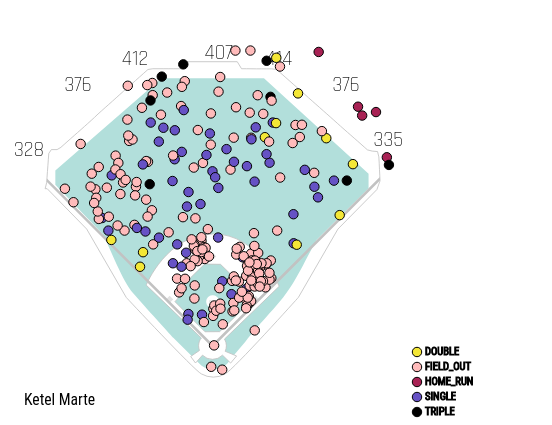
RHB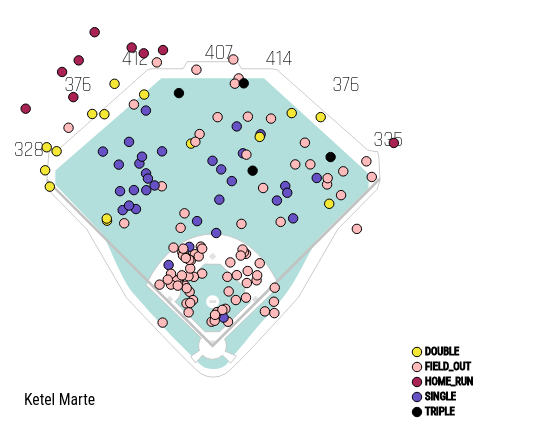
From the left side, we see a preponderance of ground ball, poor quality contact primarily to the pull side. Also, notice that his power from the left side is more of the extreme pull variety so right down the line similar to a Didi Gregorius type. Whereas from the right side he has shown an impressive ability to drive the ball more toward Left-Center. Notice too the few doubles and a home run to the opposite field from the right side. We don’t see any extra-base ability to the opposite field from the Left side. So it would appear right now at least that Marte is a noticeably more limited hitter from the Left side. And it’s something that appears to be holding him back right now.
Considering Marte is a switch hitter it’s stands to reason that perhaps there may be an incongruity from the left side of the plate. Despite what Jose Ramirez might have you believe make no mistake about it switch-hitting is a perilous endeavor. Marte’s own hitting coach last year even admitted: “it’s double the work”. And a lot about his stance has changed. Particularly from the left side. It’s worth mentioning here that Marte is a natural righty who started switch-hitting just before the Mariners signed him as an international FA at age 16. Let’s now take a closer look at how Marte’s stance from both sides of the plate has changed the past three years.
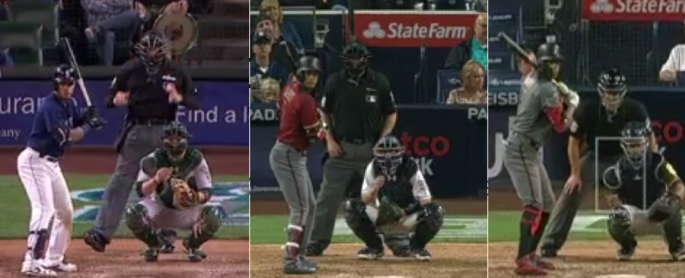
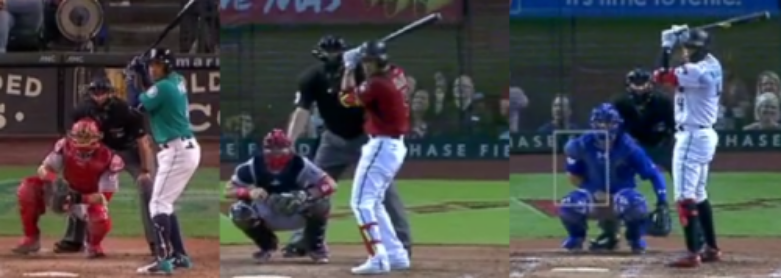
Both images progress from left to right 2016 to 2018. From the right side, the changes aren’t too noticeable. Basically, he’s more straight in the box and holds his bat at less of an angle since his Mariner days but the relative positioning of the hands and feet are very similar. From the left side in 2016 with the Mariners, you’ll notice his stance was more crouched and open. Then he was traded to Arizona and sent to AAA after failing to make the roster out of Spring Training whereupon he made a significant adjustment to his stance in an effort to generate more power. From the left side, he closed off his stance and got more upright in the box. He has continued to alter his left-handed stance in 2018. Notice the change in hand position and bat angle compared to 2017. His hands are up higher this year.
Alterations to his left-handed swing continued in 2018 too. During the first month-plus of the 2018 season, Marte got into some bad habits mechanically from the left side. Basically, he was getting on top of the ball resulting in a lot of poor batted balls to the pull side. And this is the second problem Marte has to overcome – too much groundball contact. Early on last year, his groundball rate spiked to over 60 percent prompting D’Back hitting coach Dave Magadan to work with Marte to adjust his swing and stay under the ball. The results were encouraging. A drop in groundball rate followed by a spike in hard-hit rate and wOBA. The poor early results really diluted his totals as a whole but once you consider the adjustments he made there is certainly reason to be optimistic regarding his left-handed outlook. It was mentioned earlier that Marte is a natural right-handed hitter and I think he certainly has more power from that side. The results were really lopsided in favor of his righty swing this past year. But to what extent is he a better right-handed hitter than left is difficult to say. We have a sporadic sample size for a young player who is clearly evolving so it’s probably not a great idea to take his career splits at face value. What they do show is a career wOBA of .325 as an RHB and .300 as an LHB. However, his minor league splits show a player with a much less discernible difference. So perhaps Marte’s true splits are less pronounced than our current sample would suggest. Regardless, continued improvement on his left-handed swing will likely remain a priority for Marte heading into 2019.
Player B Revealed
So let’s finally circle back to player B. Similar to Marte, he was excellent at making contact but scouts were ambivalent in projecting his future power potential. After all, he had not hit more than six home runs in any season in the minors. After his third year in the majors, he refined his approach and boomed.
| xHR | xOBA+ | VH% | PH% | EV | LA | DB% | GB% | LD% | HD% | FB% | PU% | |
| Marte 2018 | 14.3 | 108.3 | 9.8% | 27.8% | 88.3 | 5.7 | 32% | 21.6% | 14% | 8.8% | 13.3% | 15.5% |
| Lindor 2016 | 15.8 | 115.8 | 7% | 27.8% | 87.3 | 7.6 | 26% | 24.9% | 16.7% | 6.7% | 13.3% | 12.4% |
| Lindor 2017 | 36.2 | 131 | 11.3% | 29.9% | 87 | 13.6 | 24.4% | 14.7% | 17.1% | 11.3% | 11.3% | 21.2% |
In 2017 Francisco Lindor’s average launch angle increased from 7.6 to 13.6. The result was a power exhibition that not too many thought he had in him as he hit a then career-high 33 home runs. I think 2016 Francisco Lindor is a similar hitter to Ketel Marte. And that, of course, goes beyond the superficial switch-hitting shortstop comparison. Their batted ball profiles and contact rates are very similar. Neither hit for any power in the minors. And both started to show some power at the major league level. It took Marte a little longer but he’s starting to show it now. Marte makes a lot of contact. But not all contact is created equal. The next step for him is to look to add more lift to his swing in order to make more regular use of his now burgeoning power.
We look at numbers a lot and because of that, it can be easy to overlook the trials and tribulations that players as people are tested with. People like Marte who have been around for a few years are sometimes swept under the rug and overlooked as known commodities. It’s that old cliche but player progression isn’t linear. Sometimes it’s an odyssey and not a straight line. Marte was always young for his level and was promoted aggressively by the Seattle Mariners. The fact that he made it to the majors at 21 as a switch hitter at a premier position is an impressive feat in its own right. And then he was traded. Something that he himself admitted was a challenge. In 2017 he didn’t make it on the D’Backs roster out of spring training. He made some changes and kept at it in AAA before eventually getting the call in late June of that year. And then a month later he tragically lost his mother in a car accident. He continued on and had a pretty special Postseason that year becoming the first player in history to triple from both sides of the plate in a single playoff game as he helped his team advance to the NLDS. They’d eventually fall to the Dodgers but not before Marte did this.
An absolute laundry-line laser beam off Kershaw. And then 2018 happened. Where in just his second MLB season with over 400 at-bats he continued some really impressive trends that we’ve dissected here. His 14 home runs this year more than doubled his previous high at any level. Sometimes it just takes players longer to tap into their potential. And I think that’s what we are seeing with Marte. The player progression here is palpable. Now the question is does he continue to build on this similar to what Lindor did following 2016? There are a couple of blemishes here no doubt we’ve talked about the work he needs to do on his left-handed swing and he hits a little more groundballs than you’d like. Generating more consistent lift on his swing will allow him to tap into his growing power and help him make the next leap. Francisco Lindor can attest to that. Needless to say, I’m a huge believer in Ketel Marte. The skills are really exceptional and now he’s starting to hit the ball with more authority. The improvements are undeniable. I think he’s one of the easier buys in upcoming drafts currently sitting at an NFBC ADP of 235. Will he continue to progress? That’s the million dollar question. But make no mistake about it Ketel Marte has improved. A lot. There’s an appreciable ceiling here and we should all be paying attention.
(Photo by Adam Bow/Icon Sportswire)
(Graphic by Justin Paradis)

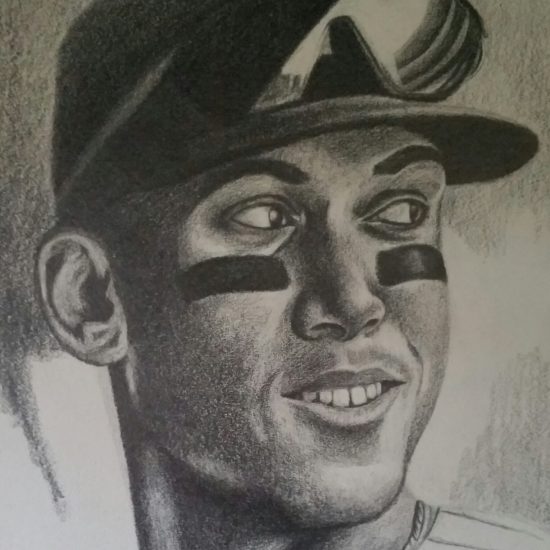
Good stuff Ryan!
I’m a big Marte fan and I love the Lindor comparison. Their profiles and their look at the plate are very similar around the same age. I would be higher on him if the humidor wasn’t installed at Chase. Hopefully he gets the chance to steal more bags in the future.
What are your thoughts on Marte abandoning switch-hitting entirely and just going from the right-side?
Hey Nick ! Glad you liked the article. It’s a great question. And it’s one I really thought about a lot actually when I was writing this. I didn’t suggest that here ultimately for a few reasons. The platoon advantage gained by switch-hitting I think is very significant and I wouldn’t want to totally discard that. Also, he’s been a switch hitter for nearly 8-9 years (shortly after he was signed at 16) so while I suppose it’s possible it just seemed like a big leap to take. While the split was really wide this year I feel it’s misleading. That first month or so last year that I mentioned really threw his totals off quite a bit I think. If you look at his rolling averages for GB rates (I didn’t include them here because I felt I was getting too long) it was pretty crazy actually. For the first 30+ games, he had a negative launch angle and a GB rate over 60. His mechanics were totally out of synch from the left side and the results were bad. While I think he has more power from the right side it’s interesting because he hasn’t really shown much of a split at all in the minors. If you look at his splits in 2017 (only 179 PA so SSS) he had much better results from the left side xBACON of .361 and xBABIP of .348. xOBA+ of 110.6. All much better than the 2018 results. Point being I think there is a fair amount of statistical noise here when you just look at his splits over a limited sample especially a player like Marte who is clearly changing.